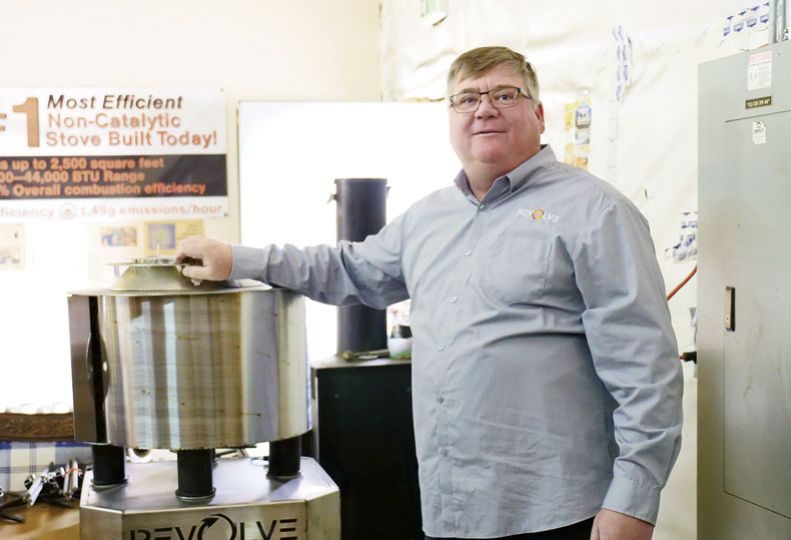
Home » Post Falls manufacturer develops smokeless fire pit
Post Falls manufacturer develops smokeless fire pit
Product line to boost sales during seasonal slowdowns

August 17, 2023
Stove manufacturer 509 Fabrication Inc., which does business as Flame Innovation, plans to overcome a slow summertime sales season with a new product line, says company founder Dusty Henderson.
“We’ve recently filed a patent on a smokeless fire pit that revolves,” he says. “The key to our patent is we’re actually spinning the flame … it’s not just coming out of the top of the fire pit.”
The Revolve Smokeless Fire Pit’s inner airfoil design results in a spinning flame and in a faster combustion of wood logs used to fuel the device, says Henderson.
In aviation, an airfoil’s purpose is to generate lift and reduce drag, according to the National Aviation Academy’s website, which says that airfoils also can be found in helicopters, turbines, and spoilers.
Flame Innovation doesn’t guarantee a completely smokefree burn, but it assures customers that it will have a clean and efficient combustion attributed to the airfoils and a secondary combustion chamber.
The Revolve series is made with two vertical damper doors located on opposite sides of the fire pit that draw in air for a fast and adjustable flow. Air travels upwards in spirals due to the airfoils and the fire pit’s center opening traps unburned gases with clean air to combust a second time.
The units also give off an abundance of heat around the sides, addressing a common complaint about a lack of heat that he’s discovered about most of the smokeless fire pits on the market.
Operating out of a 7,500-square-foot manufacturing facility at 6512 W. Seltice Way, in Post Falls, Flame Innovation has five employees who laser-weld fire pits by hand in five sizes and in two versions—a stainless-steel model, and what Henderson describes as an economical option that’s made with a painted black steel.
All parts of the fire pit, except for the top ring, are made of 1/16-inch steel, according to Flame Innovation’s website.
Production can reach up to 20 units a day depending on the model size, Henderson says. Fire pit sizes vary from an 8-inch diameter, 7-pound tabletop model; two sizes of portable models with 12-inch and 16-inch diameters that weigh about 30 pounds; up to the larger 22- and 27-inch diameter fire pits for backyards and patios that can weigh about 60 pounds.
Henderson says that fire pit production is carried out with a handheld laser welding machine that takes about two weeks to learn to operate and saves between 10% and 20% on electric utility costs for the company, compared to a normal welding machine.
The smallest fire pit in the Revolve series costs $110 for the 8-inch model. The 27-inch models cost $400 for the painted steel version and $600 for stainless steel, according to the company’s website.
About 100 units have been sold since the product launched this spring, Henderson says.
“The big reason we decided to build the Revolve was to give us sales in the offseason of stove sales,” he says.
Stove sales typically heat up by late summer, followed by a spike around the holidays, and sales begin to taper off around February, says Henderson.
Smokeless fire pits aren’t a new concept, and their popularity has been increasing over the past decade, explains Henderson. Only a few smokeless fire pit manufacturers were in the market with Henderson’s company until last year, when he says the industry ballooned to about 30 companies—each with their own version of a smokeless fire pit.
Henderson says, “Everyone uses the same smokeless technology, so we wanted to bring a product that’s made in the USA, and that is completely different, if we’re going to compete in that marketplace.”
Henderson says that despite slow seasonal sales and a crowded market, sales have grown 30% to 35% year-over-year. By the end of 2023, he anticipates about $750,000 in annual revenue.
Henderson says he began developing 509 Fabrication’s first product, the Optimum, a vertical-burning stove fueled by compressed logs, in 2015. The company incorporated in 2017 and launched the Optimum stove a year later.
After about eight years in the business, he says he’s noticed that operating costs have increased for materials, labor, and shipping.
Prices have doubled for the company to purchase its shipping pallets, and costs have risen five-fold for steel materials, he says.
“Our shipping costs have basically doubled in the last two years with the cost of fuel and all of the turmoil in the trucking industry with a lack of drivers,” he says. “It takes a lot longer to get our products to the consumer than it did two years ago.”
The company ships products in the U.S. and Canada, adds Henderson.
To keep sales flowing year-round, Flame Innovation will continue making stoves, stove accessories, and steel signs, says Henderson.
“We make a lot of metal signs that we sell at fairs … and hardware stores,” he says.
Flame Innovation also is working with independent manufacturing representatives that will market products to other retailers across the country. Later this fall, the company will expand its products overseas into Europe, he says.
Last month, Flame Innovation released two compact stoves marketed as alternative heating solutions for tiny homes, cabins, and recreational vehicles.
The 90-pound Caboose Tiny Wood Stove can be mounted on a wall or stand freely in a room, says Henderson. The unit can heat spaces up to 600 square feet in size.
The second product announced in July was the 509 Mini Me Tiny Stove. No electricity is required to operate the tiny stove, which uses gravity to feed pellets down a hopper to the unit’s combustion chamber. Burn times range from eight to 12 hours depending on the size of the stove purchased and density of the fuel.
“We started with one product to sell … the Optimum,” he says. “We have so many products now, and we care about trying to be innovative, to burn clean, and burn efficiently.”
Henderson says the corporation’s legal name, 509 Fabrication Inc., is a nod to the area code for Eastern Washington and is meant to signify the company is based in the Inland Northwest. Its products are available for sale at its headquarters and at flameinnovation.com.
Latest News Up Close Manufacturing North Idaho
Related Articles





